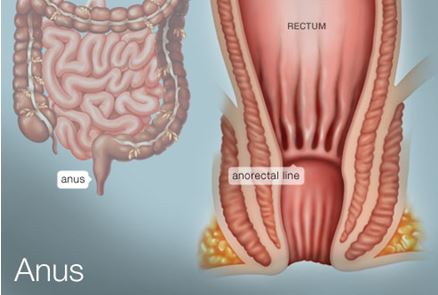
The Anus and the rectum are the final stages of our digestive system. The rectum is the final straight section of the large intestine before reaching the Anus.
The Anus and the rectum are the final stages of our digestive system. The rectum is the final straight section of the large intestine before reaching the Anus. The Anus is the opening situated at the lower end of the digestive system, which basically controls the expulsion of faeces. The Anus starts at the bottom of the rectum, which is the last portion of the large intestine. The anorectal line separates the Anus from the rectum
The waste or the faeces passes from the rectum, through the anal canal, and finally out through the Anus.

Before the faeces are expelled from the body, the rectum provides as a temporary storage for the faeces. When the rectal walls expand due to accumulation of faeces, the stretch receptors in the rectal walls stimulate the desire to defecate. Then the peristaltic waves push the faeces out of the rectum.
The Anus is basically the external opening of the rectum. The expulsion of the faeces is controlled by the Anus. The muscle called as anal sphincter controls the flow of faeces through the Anus. The external and the internal sphincter muscles relax, thus allowing the faeces to be passed through them and pulling the Anus up over the exiting faeces.
The main function of the external anal sphincter is to keep the exit closed throughout the day. If ever we make an effort to close the floodgates during diarrhoea, it is the external anal sphincter muscle that we are controlling. The external anal sphincter is made of skeletal muscle and it is a distinct muscle that contracts during defecation.
The internal anal sphincter is an involuntary muscle, which does its tasks on its own without any orders. It basically keeps the faeces from leaving the body before the right time and when the time is right it also helps them escort out of the body.
The terminal part of the large intestine is the anal canal. It is situated between the Anus and the rectum, right below the level of the pelvic diaphragm. The anal canal is approximately about 2.3 cm to 3.5 cm long and it is surrounded by external and internal sphincters. The layer of voluntary muscle encircling the outside wall of the anal and the anal canal is the external sphincter, whereas the internal sphincter is the part of the inner surface of the canal. The internal sphincter comprises layers of circular muscle tissue, which are not under voluntary control.
There are many conditions associated with the malfunctioning of Anus:
-
Anal itching: The itching in and around the Anus is the most common problem. There is basically no serious cause responsible for the itching.
-
Anal fissure: Anal fissure is the tear in the lining of the Anus, mostly caused due to constipation. The main symptom of anal fissure is pain, especially pain with the bowel movements.
-
Internal haemorrhoid: These are basically swollen veins inside the Anus or the rectum and they cannot be seen from outside of the body.
-
External haemorrhoid: External haemorrhoid is the swelling of the blood vessels near the opening of the Anus or the bulge outside the Anus.
-
Constipation: This is the most common problem associated with Anus. The person experiencing it faces difficulty in passing stools, and it also causes Anus pain, anal fissures or even bleeding from the haemorrhoids.


